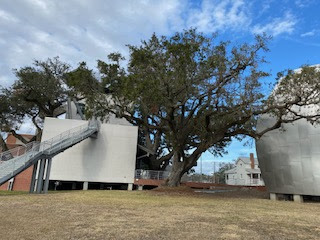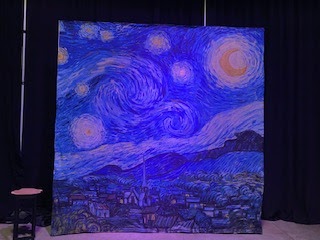Frank Gehry and GulfCoast art
 |
| The pods (at right) hold the George E. Ohr exhibit; the structure at left is the City of Biloxi Center for Ceramics. An ancient live oak tree is in the center. |
 |
| Frank Gehry continues his use of stainless steel on the campus of the Ohr-O'Keefe Art Museum. The architect's stainless steel works here as it reflects the majesty of the live oak trees. |
What does one of the world's great architects have to do with four acres of land along the Mississippi GulfCoast?
Frank Gehry, Los Angeles, was introduced to the unusual property in 1998 and subsequently designed the Ohr-O'Keefe Museum of Art campus in Biloxi. He was entranced by the site which included ancient live oak trees that had to be preserved.
In addition, Gehry was familiar with George Ohr, a native of Biloxi who was a creative pioneer in the art of ceramics. He had respect for Ohr, who's collections are now owned by artists such as Jasper Johns and David Whitney.
Early in his career Gehry worked in ceramics before he studied architecture.
By now, Gehry is known for structures such as the Guggenheim Museum in Bilbao, Spain; the Loyola Law School in Los Angeles, the Olympic Fish Pavilion he created for the Olympics in Barcelona, Spain, and the Weisman Art Museum in Minneapolis, Minn. One of his most exciting works is the EMP Museum, at the Space Needle in Seattle.
For his part, Ohr, born in 1857, was perhaps a century ahead of his time. Called "The Mad Potter of Biloxi," he studied under Joseph Fortune Meyer of Newcomb College Art Pottery, in New Orleans, La. Through this association he was introduced to the best of the Arts & Crafts movement and the American Renaissance.
He started with utilitarian pieces, and expanded his vision, utilizing a personal relationship to his work. In 1884 he lost 600 pieces of his ceramics, after he attended the World Industrial and Cotton Centennial Exposition in New Orleans. There was more work lost in 1894 as a fire destroyed his studio and artworks. Ohr was able to salvage some items from the fire and called them his "burned babies."
After that catastrophe Ohr started to experiment with shape and color, and came up with unusual and vibrant glazes and forms of distinction; ultra thin pieces that were folded, twisted or ruffled.
He got his clay from the nearby Tchoutacabouffa River. He dug and processed his own clay with the help of an apprentice. He had unshakeable faith in his work and wanted one place to purchase it, offering the collection to the New Orleans Museum of Art, and to the Smithsonian. Neither place agreed to buy it.
In 1910 he packed away the pottery and asked his heirs to keep his collection untouched for 50 years after he died.
In 1969 an antiques dealer named James Carpenter purchased the Ohr collection and introduced the work to collectors in the Northeast. Slowly but surely Ohr's work was finally noticed and appreciated.
Here's a self-description at the Ohr-O'Keefe Art Museum:
I KNOW
I'm quaint & very queer,
So is my work, so I appear;
As I write I likewise talk & work,
& otherwise I could not B-
I am no poet, but just mud-
And term myself
POT-OHR-E
Gehry, born in Canada in 1929, first became famous in 1978 when he designed a house for himself and his family located in Santa Monica. It was described as a bungalow wrapped in everyday materials like plywood and chain link. The house was "cheered and jeered," at first, according to an account in Architectural Digest. But in 2012 it won the American Institute of Architects prestigious 25-Year Award.
In 1988 Gehry translated his passion for sailing into the design of a new home for the Los Angeles Philharmonic Orchestra. The Walt Disney Concert Hall finally opened in 2003; the stainless steel exterior now "sails" above Grand Avenue in Los Angeles, said the 2018 article, "31 Buildings by Frank Gehry" found online here: https://www.architecturaldigest.com/gallery/best-of-frank-gehry-slideshow.
Near us in Davenport, Iowa, notable Gehry art is the Jay Pritzker Pavilion at Millennial Park, Chicago.
We visited the GulfCoast area in December and I happily explored the artistic campus one sunny afternoon. It is mostly closed at this time, but it's also easy to get a sense of the immense talent and versatility behind the design and its ceramic attractions.
For online information: georgeohr.org



Comments
Post a Comment